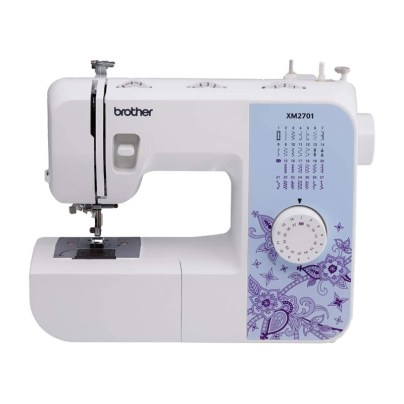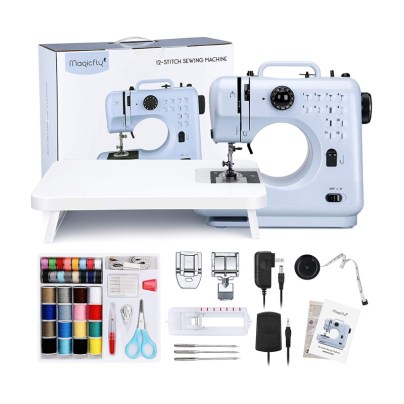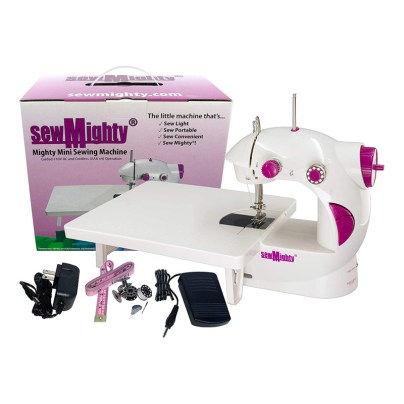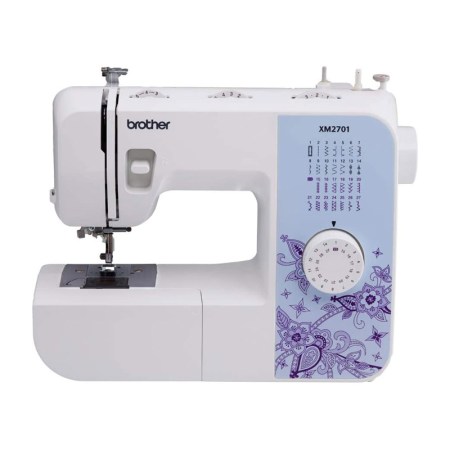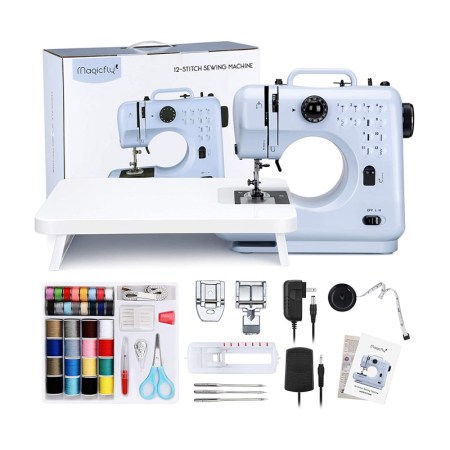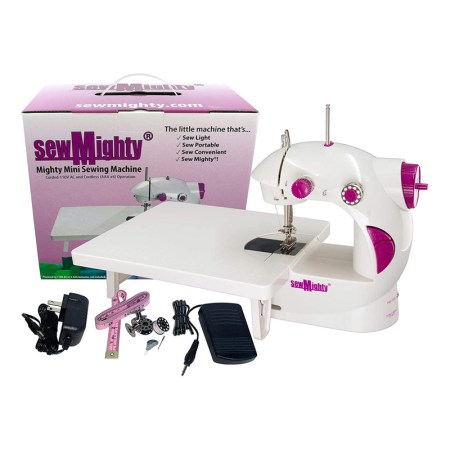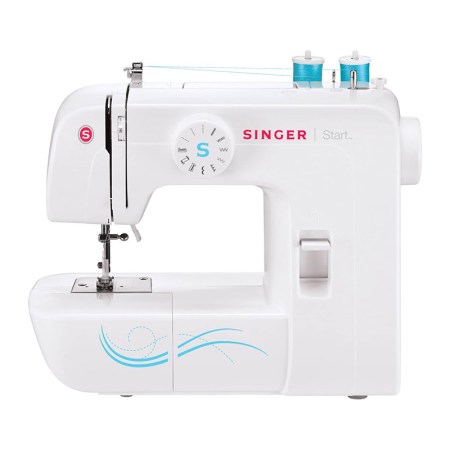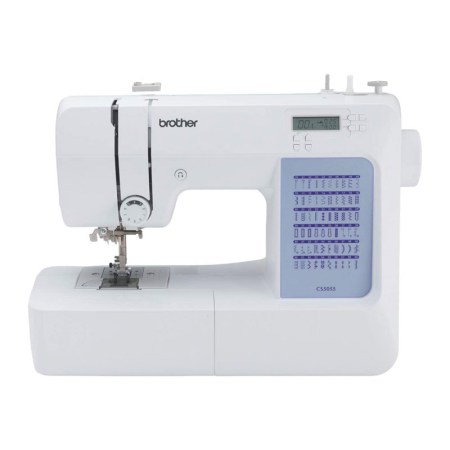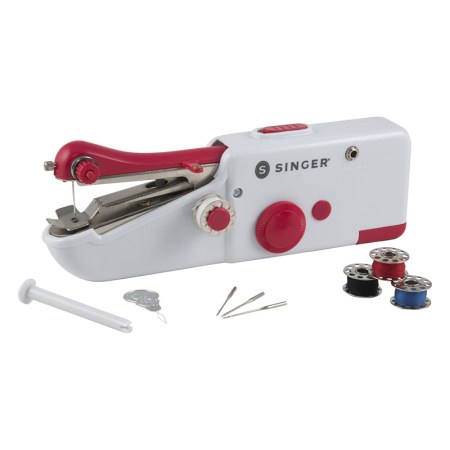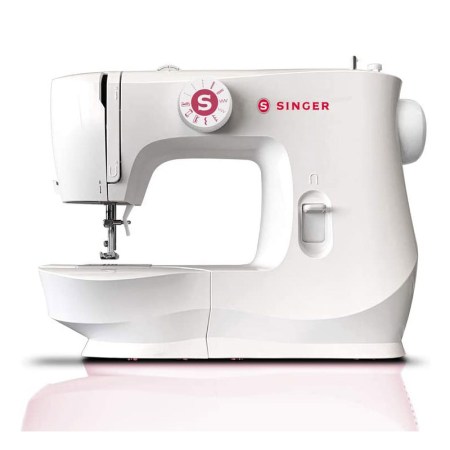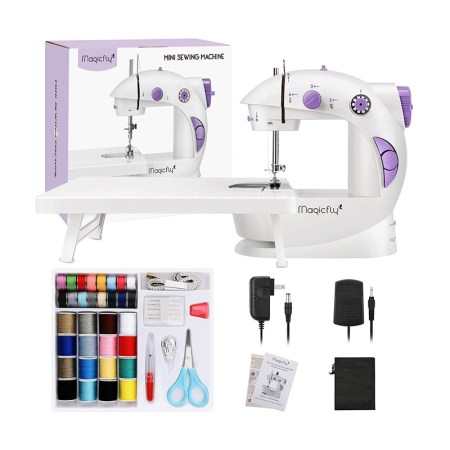We may earn revenue from the products available on this page and participate in affiliate programs. Learn More ›
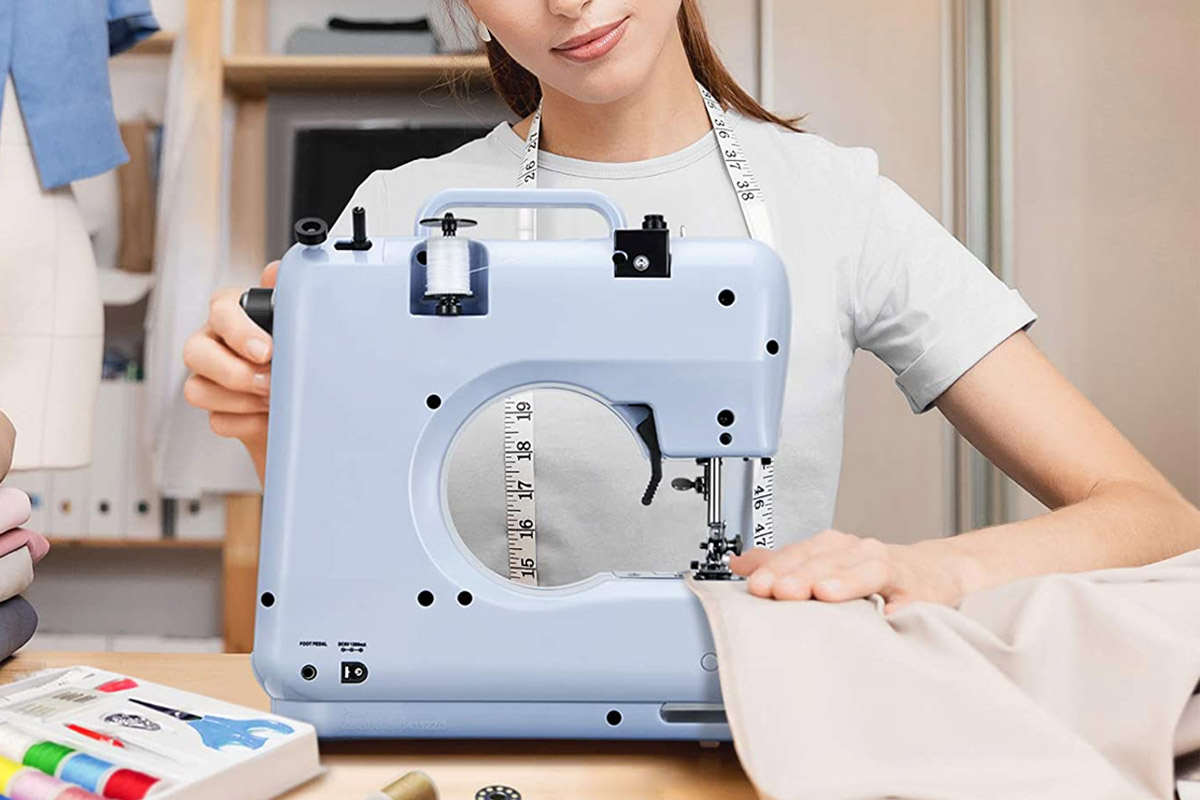
Perfect for adults or kids interested in learning how to sew or who find themselves short on space, mini sewing machines are smaller and more affordable than full-size versions. Manufacturers often tailor these compact devices to beginners with plenty of user-friendly features, such as simple stitch settings and automatic needle threading. Experienced sewers will love the convenience of a lightweight option that is both compact and portable.
Choosing the best mini sewing machine can be difficult since models vary greatly in size, quality, and features. This guide will help shoppers select the best machine to suit their needs.
- BEST OVERALL: Brother XM2701 Sewing Machine, Lightweight
- BEST BANG FOR THE BUCK: Magicfly Portable Sewing Machine
- BEST LIGHTWEIGHT: Sew Mighty Portable Sewing Machine
- BEST FOR BEGINNERS: SINGER Start 1304
- BEST FOR SKILLED USERS: Brother CS5055 Computerized Sewing Machine
- BEST HANDHELD: SINGER 01663 Stitch Sew Quick
- BEST FOR THICK FABRIC: SINGER Mechanical MX60 Sewing Machine
- BEST FOR GIFTING: Magicfly Mini Sewing Machine
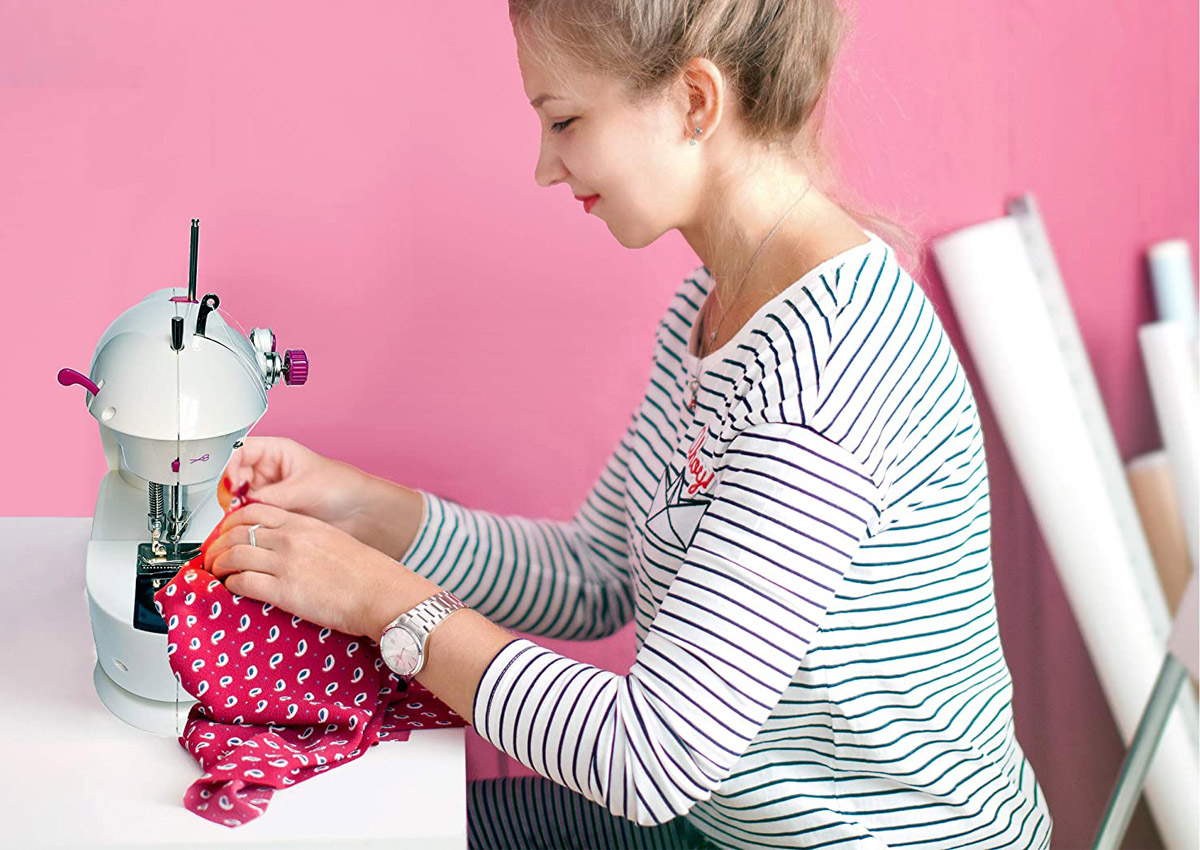
What to Consider When Choosing the Best Mini Sewing Machine
Before choosing the best mini sewing machine for your home, there are a few things to consider. From size and weight to stitch and needle settings, users will want to determine which model is best geared to their skill level and intended projects. Keep reading for some key features to look for while shopping.
Standard vs. Handheld
Handheld models make up the smallest end of the sewing machine spectrum. Most handhelds are lightweight and operate by batteries, so they are extremely portable. However, the compact size sacrifices some functionality.
Handheld options work well for a quick fix, but they have fewer features than standard mini machines, which often have many of the characteristics of their full-size counterparts. Handheld models are useful for mending loose seams and tears, for stitching practice, or to make crafts, but they won’t stand up to thicker fabric or major output.
Standard mini machines can tackle larger projects. However, they might not accommodate thick fabrics such as denim and leather as well as their full-size counterparts.
Size and Weight
One of the biggest benefits of a mini sewing machine is the compact size. Full-size sewing machines can be quite hefty, weighing between 15 and 30 pounds, depending on the model. Mini versions weigh much less, typically ranging from about 2 to 13 pounds, with the average weighing about 10 pounds. Handheld options are the lightest and most portable, commonly weighing less than a pound.
On average, mini sewing machines will measure 7 to 15 inches long. Those with expandable arms to accommodate quilting can be a bit longer. Their compact nature will allow the user to work at a sewing table or use their purchase in various rooms and locations.
Material
Standard sewing machines are made from either plastic or metal. Mini versions are often plastic, so they weigh less—and cost less. Metal machines usually have greater durability and a longer lifespan, but the material is most often found in full-size or industrial models used for sewing and mending thick materials. A variety of metals are common to the machine’s fittings, including steel and brass.
Skill Level
The best mini sewing machine for a home will suit a user’s skill level without sacrificing capabilities. Many mini options are made for beginners, featuring straightforward, simple parts and dials, since too many features can easily overwhelm novice sewers. For those enrolled in a sewing class or group, a lightweight machine is perfect for transporting.
Features such as an easily adjustable stitch speed, drop-in bobbin, and automatic needle threader can help beginners get started more easily. More experienced sewers will benefit from the convenience of these automated features as well, but they will want to choose a sturdy machine with more stitch options and added features such as a presser foot and free arm.
For those who mainly sew seams, consider a serger machine. Made specifically for this task, a serger machine can produce professional-level seams.
Stitching
Beginner sewers usually work with two main stitches—straight and zigzag—which are often the minimum available on mini sewing machines. A small stitch selection should suit new users fine, but more experienced sewers might want additional options, at the very least a top stitch or backstitch. It’s also worth noting a machine’s stitch length settings, since some will be standard and others will include variable options.
Most mini sewing machines feature buttons or an easy-to-use dial with visual indicators of each stitch speed. Higher-end models might include digital settings.
Needle and Bobbin Features
For beginners and experienced sewers alike, manual needle threading can be a hassle. Though threading a needle is an important skill to learn, an automatic threader can save lots of time, especially for quick fixes. Fortunately, most mini sewing machines come equipped with this useful feature.
Different needle positions will give the user varying degrees of control so that the stitch lands in the right place. Some machines feature a stitch width dial to allow the user to move the needle to the right, left, or center position.
A bobbin is a small cylindrical spindle that holds the thread. It might go in the front of the machine or drop into the base to provide thread from the bottom part of the machine for a full stitch. The thread feeds through a loop and up to the needle plate. Beginners will find a drop-in bobbin system the simplest method, and the feature is common to mini sewing machines.
Additional Features
Mini sewing machines also might come equipped with a presser foot and a free arm. A presser foot will assist in holding the fabric flat as it feeds through the machine and stitches, so it’s a nice accessory to have for more precise stitching. A free arm is a smaller work surface built into the machine for stitching hems on narrower fabrics such as sleeves or pant legs.
Regular sewers swear by a lighted work area. Consider models that have a built-in LED light, which can help avoid eye fatigue while sewing. An extension table will also help create an efficient work space.
Finally, some mini machines come with sewing accessories. Beginners in particular might enjoy a unit that includes the bonus of needles, bobbins, scissors, and more.
Our Top Picks
The best mini sewing machine options are both compact and easy to use while not sacrificing on features and capabilities. Consider one of the following options, which check many of these boxes and more.
Best Overall
Brother XM2701 Sewing Machine, Lightweight
See ItThis Brother XM2701 mini sewing machine is beginner-friendly with an automatic needle threader, a jam-resistant drop-in bobbin, and automatic bobbin winding system. Beginners will find setting the stitch a simple step using the dial and visual indicators on the machine. Twenty-seven stitch settings, including an auto-size button hole and variable length options, allow users to tackle a variety of projects.
A free arm helps when sewing sleeves and pant legs. The machine also comes with an LED light to illuminate the work surface. It also features added accessories, including six sewing feet, a three-piece needle set, a twin needle, four bobbins, and an instructional DVD. The company offers free technical support via live online chat or phone for the life of the machine.
Best Bang for the Buck
Magicfly Portable Sewing Machine
See ItThis Magicfly portable sewing machine can provide a boost for beginners at an affordable price. It offers an easy-to-use dial for selecting the desired stitch according to a visual guide on the machine. It includes 12 options, ranging from straight to zigzag. A backstitch lever adds to its versatility, while a second dial makes it simple to adjust the upper thread tension.
This mini sewing machine lacks an automatic threader. However, a guide printed on the body assists with the process. Other useful features include an extension table, an integrated drawer for accessories, an LED light, and a thread cutter. A large accessory kit includes three presser feet, buttons, zippers, a tape measure, scissors, and a complete set of thread spools.
Best Lightweight
Sew Mighty Portable Sewing Machine
See ItWith just two stitch speeds and a 9 3/4-inch extension table, this mini sewing machine is a good choice for beginners and children. Users will have to thread the needle manually, but an automatic bobbin winder and thread tension controller add to its easy functionality. A two-speed motor activates by a dial or via the included foot pedal.
As an added bonus, this machine can plug into an outlet or run on battery power. It comes with two prewound metal bobbins with black and white thread, two empty metal bobbins, and a replacement needle.
Best for Beginners
SINGER Start 1304
See ItThe SINGER Start mini sewing machine is preprogrammed with six built-in stitches, preset for width and length, which users can select easily by turning a dial. A threading diagram helps get the needle ready, and a four-step buttonhole feature allows beginners to easily add buttonholes.
Built to last, the unit features an interior metal frame and stainless steel bedplate. Though it’s sturdy, it’s still lightweight, weighing under 10 pounds. A handy reverse stitch lever and three presser feet add to the beginner machine’s versatility. Accessories include a pack of needles, bobbins, needle plate screwdriver, and a detailed user manual.
Best for Skilled Users
Brother CS5055 Computerized Sewing Machine
See ItThe Brother CS5055 Computerized Sewing Machine stands out for its LCD screen, which displays options users can select from 60 built-in stitches and seven auto-size buttonholes. The unit is durable, with a solid metal frame and a fixed needle bar to enable precise stitching, while a small free arm helps tackle cuffs and pant hems.
With an automatic needle threader, a jam-resistant drop-in bobbin, and an LED light, the machine also boasts user-friendly features. Between the many stitch options and seven included sewing feet, sewing enthusiasts and crafters can tackle a wide array of projects. The device also comes with several needles, bobbins, and other sewing accessories.
Best Handheld
SINGER 01663 Stitch Sew Quick
See ItThe SINGER 01663 Stitch Sew Quick measures 9 inches long and weighs under a pound for easy transport within the home or when out and about. The device comes prethreaded and ready to use, but it lacks any automatic features. It boasts an affordable price point and convenient size, but it’s best for mending lightweight fabrics.
A built-in power switch turns the portable machine on and off for safe use. The machine comes with bobbins, needles, a thread spindle, needle threader, and an instruction booklet.
Best for Thick Fabric
SINGER Mechanical MX60 Sewing Machine
See ItHelpful for those just getting started, an intuitive dial on the SINGER Mechanical MX60 allows users to select from six built-in stitches, each with a preset width and length, or a four-step buttonhole setting. An all-metal interior frame adds to the device’s durability and stability, which helps it resist skipping stitches.
This unit is sturdy, yet at 12 pounds, it’s light enough to take along to a sewing group or class. Other features include an automatic threader, thread tension dial, and a front-loading bobbin.
Best for Gifting
Magicfly Mini Sewing Machine
See ItA bit simpler than the company’s portable version, this Magicfly mini machine features two speeds, so both kids and adults can easily get started sewing. Recipients can jump into projects right away with the 42-piece sewing accessory kit, which includes 36 bobbins, five needles, a threader, scissors, a measurer, an extension table, and a portable bag.
Users control speeds for basic stitching via a button or foot pedal, and an LED light helps to reduce eyestrain. This machine is not appropriate for thick fabrics and lacks an automatic threader, so users will have to learn the six-step process for threading the machine. However, it includes a thread cutter, tension screw, and a self-winding drop-in bobbin.
FAQs About Mini Sewing Machines
Now that you’ve learned what to look for while shopping for a mini sewing machine, you might be wondering what thread to use or why it might skip stitches. Get the answer to these and other commonly asked questions about your new device below.
Q. Can mini sewing machines work the same as regular sewing machines?
Mini sewing machines work the same as full-size machines; however, the size often prevents them from accommodating thick fabrics such as denim and leather. In general, the stitches might not be as thick or secure as those of a regular machine.
Q. What types of thread should I use for a mini sewing machine?
You can use standard cotton or polyester thread for your mini sewing machine.
Q. Why does my mini sewing machine skip stitches?
There are several reasons your machine may be skipping. Some mini machines tend to skip stitches if they have insufficient clamping, so make sure the unit is holding the fabric in place sufficiently. It’s also a good idea to see that the needle is threaded properly and still sharp. Double-check the bobbin to make sure it is wound properly as well. Also, be sure to clean the machine regularly to keep it working properly.
